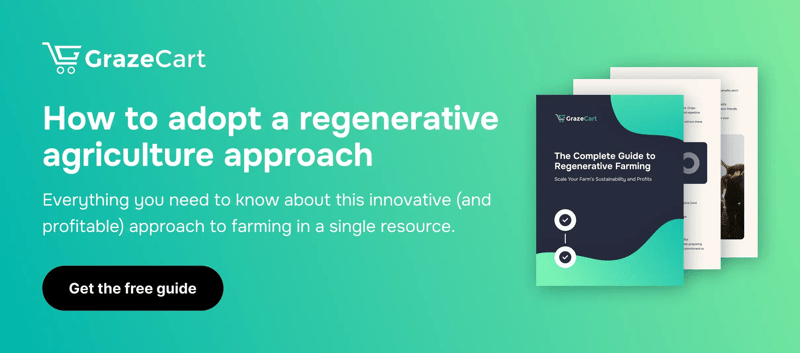Today’s consumers are more worried than ever about the environmental impact of conventional meat production.
While some have committed to vegetarian or vegan diets to avoid factory farming, others have embraced the farm to fork movement. These eco-friendly eaters are turning to local farms like yours for sustainable, ethical, and delicious options.
Adopting a regenerative agriculture approach can help you appeal to these environmentally conscious customers and protect the planet — all while increasing the quality of your beef.
In this blog, we’ll explore the basics of regenerative cattle ranching, introduce three key best practices, and share how to turn your efforts into profit.
Regenerative Cattle Ranching: The Why
Before we dive into specific regenerative beef farming methods, let’s cover the basics.
Regenerative agriculture hinges on one core principle: working with the land instead of against it. Regenerative farmers believe that protecting and nurturing soil health, native plants, and water quality will lead to more plentiful yields and higher quality livestock.
So, what does regenerative cattle ranching actually entail? Let’s look at three key components of a sustainable approach to beef production.
1. Rotational Grazing
Unfortunately, traditional livestock grazing practices are tough on your farmland. If you leave your cattle in a single pasture for too long, they’ll trample and overeat the grasses.
Rotational grazing is the regenerative solution to this problem. This strategy involves dividing up your pastures and rotating your herds through them, giving the soil time to recover and allowing native grasses to regrow.
Along with boosting biodiversity and preserving the long-term health of your pastures, rotational grazing increases the amount of food available for your cattle, saving you money, eliminating the need for supplemental feed, and helping you raise healthier livestock.
2. Composting
Composting is another essential part of a regenerative cattle ranching plan.
Your herds constantly produce waste, and without a proper waste management plan, it can ruin your pastures, pollute nearby water sources, and contribute to greenhouse gas emissions.
Composting allows you to turn this waste into something useful, eliminating the need for expensive, artificial fertilizers.
You can use this composted cattle manure to fertilize your fields and boost crop yields, or you can apply it to your grazing lands to encourage grass growth and increase the food supply for your cattle.
3. Protecting Native Plants
Healthy soil and native plants go hand in hand, which is why your regenerative beef farming approach should encourage plentiful native plant growth.
Native plants have several benefits for your farmland. They enrich the soil with nutrients, protect against erosion, attract helpful insects and pollinators, and provide a sustainable source of food for your cattle — all while ensuring the long-term sustainability of your grazing lands.
So, how can you encourage native plant growth? Here are some of the most effective strategies:
- Plant cover crops to protect your planting fields and grazing pastures
- Avoid artificial fertilizers and pesticides that might hurt native plants and pollinators
- Minimize tillage to avoid disturbing native plants and soil nutrients
Check out our comprehensive guide to regenerative farming for more tips on protecting native plants and soil health.
Bonus Tips for Selling Regeneratively Farmed Beef
Just like raising cattle requires the right strategies, you need the right tools to turn your farm-fresh beef into a profit.
Most importantly, you need a point of sale (POS) solution specifically designed with the farm to fork movement in mind. GrazeCart is an all-in-one tool that lets you sell farm products online or in store.
Our powerful software makes it easy to sell beef by the pound, track perishable inventory, offer farm subscription boxes, and more. GrazeCart’s website builder, loyalty program, and email marketing tools make building customer relationships easy.
Ready to see how regenerative cattle ranching and the right farm software can boost your sustainability and revenue? Start your free, two-week trial of GrazeCart today!

 by
by 
